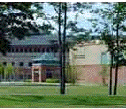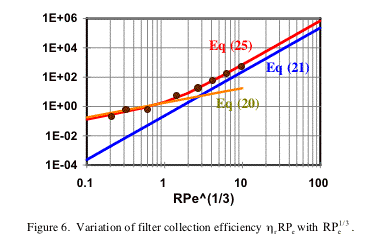




















|
|
Particle Deposition Mechanisms: Diffusion to a Cylinder Fiber Efficiency/Filter Efficiency Rearranging and integrating (23), it follows that
where L is the length of the filter. For
|
|
|||||||||||

|
(25) |
which correlates well with the data as shown in Figure 6.
Note also that Equation (25) reduces to (21) as
 . For Re=0.1,
the predictions of Equations (20) and (21) are shown in Figure 6 for comparison.
It is seen that the prediction of Equation (20) for the diffusion limit is in good
agreement with the result of (25) for small Peclet numbers. Similarly the
prediction of Equation (21) for the interception limit asymptotes the empirical
Equation (25) at large Peclet numbers.
. For Re=0.1,
the predictions of Equations (20) and (21) are shown in Figure 6 for comparison.
It is seen that the prediction of Equation (20) for the diffusion limit is in good
agreement with the result of (25) for small Peclet numbers. Similarly the
prediction of Equation (21) for the interception limit asymptotes the empirical
Equation (25) at large Peclet numbers.




 the following
semi-empirical equation was suggested (Hinds, 1982):
the following
semi-empirical equation was suggested (Hinds, 1982):